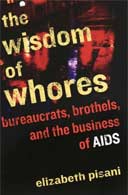
The Wisdom of Whores: Bureaucrats, Brothels and the Business of Aids
by Elizabeth Pisani
Granta £17.99, pp372
When it comes to statistics, particularly medical statistics, most of us casually absorb what we read in the press with barely a moment's thought as to how the figures in question were arrived at. If we should read, for example, of a rise or fall in the rate of HIV infection among transgender sex workers in Jakarta, how many of us would pause to consider that behind those percentages are teams of dedicated field workers taking anal swabs night after night in red- light districts or battling with the difficulties of getting a cooler full of frozen blood samples past a police roadblock before the night's work defrosts (not to mention the difficulty of persuading clubbers or prostitutes to let them take the samples in the first place)?
For the past decade, epidemiologist Elizabeth Pisani has been one of the experts 'on the ground' behind the statistics on HIV and Aids offered not just to newspapers but to governments and international organisations with responsibility for prevention and treatment programmes upon which millions of lives depend. A former news journalist with a degree in classical Chinese and a PhD in infectious-disease epidemiology, Pisani believed that when it came to epidemiology, good science was not enough - it had to be translated into good public health policy if it was to have any value.
'We could save more lives with good science if we spent less time worrying about publishing the perfect paper and more time lobbying, more time schmoozing the press, more time speaking in the language that voters and politicians understand,' she explains in the preface to this lively, accessible and eye-opening account of a decade spent at the coal-face of Aids prevention and treatment strategy.
Pisani writes with candour and humour, both essential given the general squeamishness with regard to the subjects she has to discuss. HIV is spread predominantly by anal sex, drug injection with dirty needles and sex with multiple partners where there is also a high level of other sexually transmitted infections, i.e. among prostitutes and their clients, she explains. In most countries outside east and southern Africa, Aids is not ravaging the general population as was once feared. Yet politicians the world over know there are few votes in spending taxpayers' money to provide expensive health care services for gay men, illegal drug users and sex workers, particularly if such services can easily look as if they are encouraging and facilitating behaviour the moral majority tends to disapprove of anyway. So figures and trends must be 'beat up' - cannily interpreted and presented in such a way as to imply that we could all be at risk.
This was part of Pisani's job in her early days at UN Aids, the UN's hasty amalgamation of various agencies all jostling for a slice of the Aids funding. Back then, in 1996, her task was to persuade rich countries, whose effective prevention programmes in the Eighties had allowed Aids to slip down the agenda, to care about the spread of the epidemic in poor ones. Later, in 2001, she moved from the theoretical domain and took up a post in HIV surveillance for the Indonesian government, doing the dirty work of mapping HIV levels among those at risk and monitoring the behaviour that creates such risk. This meant nights of hanging out on Jakarta street corners, asking waria (ladyboys) if they prefer to be the receptive or insertive partner in anal sex. It meant trips to red-light districts that were little more than slums to ask soldiers, sailors and civil servants if they had wives at home and if they used condoms. It meant loitering at remote railway stations waiting for junkies to come and shoot up.
It is in these stories from the frontline that Pisani's book really comes to life. If she has a mission statement, it is that public health policy should be based on reality and that a wilful refusal at the highest levels to confront the often messy reality of Aids has led to billions of dollars of aid money, not to mention millions of lives, being wasted. She is furious at the faith-based initiatives that have mushroomed under Bush, diverting badly needed prevention money into programmes that teach abstinence-only, or campaign against prostitution and condemn all attempts to make commercial sex safer and better regulated as abetting a form of slavery.
She is not afraid baldly to state truths unpalatable to liberals either. In her experience, Pisani says, the majority of female sex workers have not been trafficked; they have simply chosen a horrible job that pays considerably better than the many other horrible jobs available to them. She also blows away the smokescreen created by the international community that the fierce spread of Aids in parts of Africa is due to poverty and underdevelopment, rather than patterns of sexual behaviour, because to state the latter might appear racist.
She even dares to say the ultimate unsayable: that the efficacy of HIV drug treatment in wealthy countries has led to complacency in behaviour, particularly among gay men, which has in turn led to a rise in new infections. The alternative is not to let people die, but to make treatment dependent on commitment to prevention programmes, she argues.
Among what she calls 'the Aids mafia', in which she includes herself, her views may be controversial, but to the lay reader, this is a fascinating and revelatory account of a world in which Aids has become a fashionable cause to which the West now pledges billions of dollars - money that has introduced corruption and greed into an already complex equation. Pisani's deliberately colloquial style cuts through the jargon - though she has an infuriating habit of referring to 'cute guys' and 'cute chicks' - and the view she opens up is often shocking but, ultimately, cautiously optimistic.

